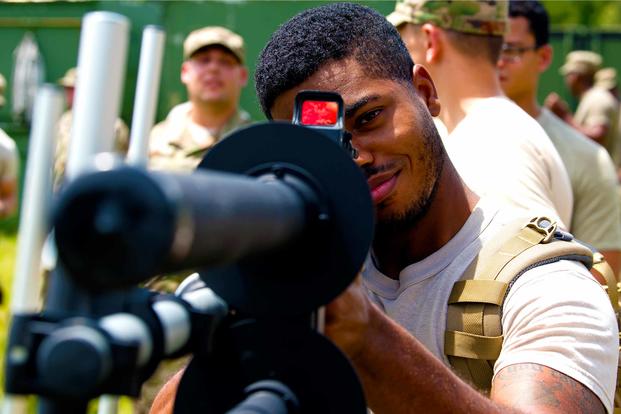As the Pentagon looks for ways to prevent small drones from targeting American bases, U.S. Air Force Security Forces will need better tools to deter the unmanned systems, which aim to disrupt base operations or spy on aircraft, according to a top general.
"We're going to need to factor in, as we look to the future, [ways to] counter small UAS," or unmanned aerial systems, said Lt. Gen. Warren Berry, deputy chief of staff for logistics, engineering and force protection. Berry spoke during a Mitchell Institute Aerospace Nation event Thursday.
Read Next: Soldier Makes History as First Woman to Join the Green Berets
"That's going to be a demand signal on this course moving forward that we're going to have to really think through," he said, adding that the Air Force is charting solutions to "make sure that we have [airmen] resourced appropriately to execute that part of the airbase air defense mission as well."
The service is coordinating with the Army-led Joint Counter-Small Unmanned Aircraft Systems Office, he said. The office recently authorized seven of 40 proposed defensive countermeasures that will be used to detect and destroy enemy drones.
Speaking of the counter-drone team, Berry said the defender force is "happy with where it's going and we continue to stay engaged," but did not specify what kind of improved tech Air Force defenders may be carrying in the near future.
Defense against small drones has become an increasing priority for the Pentagon in recent years, especially as the systems can easily be obtained.
Some bases already have defenses against small unmanned aircraft; for example, U.S. Strategic Command, which oversees the nuclear arsenal, and Air Force Global Strike Command last year began using "a command-and-control capability integrated with some detection and some jamming," according to Steve Wert, the Air Force's digital program executive officer, as reported by Air Force Magazine.
The force protection enterprise has already seen recent advancements in base defense.
Berry said the team just finished up "900 action items" as part of Chief of Staff Gen. David Goldfein's Reconstitute Defender Initiative, or RDI, to revamp the Security Forces career field.
One of the changes includes the fielding of a new sidearm. Last month, the service announced it will soon start providing defenders with the Army's new Modular Handgun Systems to replace its Cold War-era M9. The Air Force plans to complete fielding of the Sig Sauer-made M18 9mm pistol by August 2022, according to a release. The $22.1 million contract includes approximately 125,000 M18s for the service.
"But this is beyond just the M9 [change]," Berry said. "Culture was a big piece of this, reinforcing that elite defender culture across the defenders from the reserve, the Guard and active duty.
"Then we noticed that we had to improve the lethality of the force, so it's about weapons, it's about personal gear, it's about communications, it's about the vehicles they use," he said.
The service awarded a contract last month for thousands of sets of body armor specifically designed to fit its female Security Forces airmen, with the aim of downsizing field gear for those guarding bases worldwide.The Air Force is also acquiring the M320 grenade launcher to replace its M203 series, Berry added.
Other upgrades include retiring and replacing the service's Humvees in favor of the Army's Joint Light Tactical Vehicle program, known as JLTV. The Air Force first requested 140 vehicles in its fiscal 2018 budget submission.
Berry said those JLTVs will first go to airmen overseeing defense for bases hosting the U.S. nuclear arsenal.
Officials also needed to revitalize training as part of the service's preparation for a potential fight with Russia or China, Berry said.
"We changed the whole mindset behind training to focus less on qualifying training and more on proficiency. … Getting them comfortable with their gear and equipment, getting them comfortable with their weapons to do more firing in simulation training, more dry firing -- things that really get after more proficiency," he explained.
Berry said the service is "comfortable" with the manpower it has for base defense. However, there are some shortages in the Security Forces field.
Without providing how many airmen the career field is short, Berry said the service doesn't meet "what the manpower models tell us we should have."
"With manpower, more is always better, right? But they're well trained and well equipped to do the mission that we ask for," he said.
-- Oriana Pawlyk can be reached at oriana.pawlyk@military.com. Follow her on Twitter at @Oriana0214.
Related: Ready for the Unexpected: Air Force Drilling Troops in Survival, Response Skills












